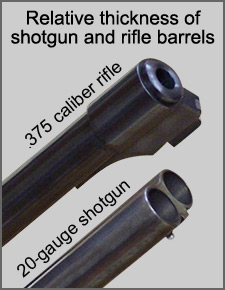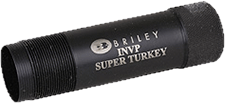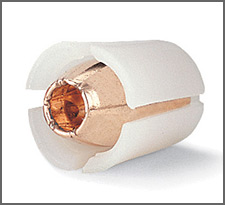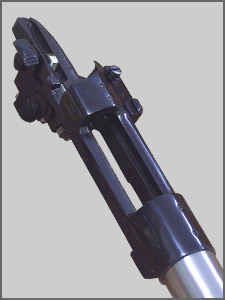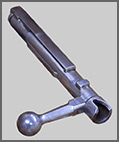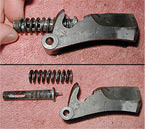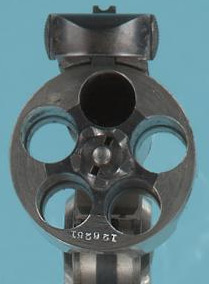Home | Glossary | Resources | Help | Contact Us | Course Map
Archival Notice
This is an archive page that is no longer being updated. It may contain outdated information and links may no longer function as originally intended.
Barrels for Muzzleloading Arms
Producing a rifled barrel for a muzzleloading rifle or handgun is similar to producing a barrel destined for a cartridge firearm. Both require spiral lands and grooves. The major difference in muzzleloader barrels is in rifling configuration, not process.
Shotgun
Unlike many rifles and handguns, shotguns are not considered point target firearms. Accuracy takes second place to the barrels ability to produce a pattern of metal pellets at the target. With relatively large bore diameters, shotgun barrels must be made with thin walls to reduce weight and bulk.
Today, the majority of shotgun barrels are hammer forged. The difference in the process is the lack of inverse rifling on the mandrel. Mandrel forming makes a straight, smooth, and uniform tube.
Shotgun chambers do not displace much barrel steel compared to a rifle chambered for a bottleneck cartridge, such as the 30-06 Springfield. It is simple to include the rough chamber on the mandrel.
Sporting shotguns are choke - bored arms which makes them ideal for hammer forging. There is a slight constriction in the final inch of the barrel that controls how fast the pellet pattern spreads. For long-range shooting, a tighter constriction is required than for short-range skeet shooting or hunting fast-rising upland birds.
Before hammer forging, choke boring required that the entire barrel be made to the choke diameter. All but the last inch must be enlarged to meet the main diameter specification, which is a tedious and expensive operation. Some chokes were cold swaged by placing a tapered die on the outside of the muzzle and pressing it down to taper both the inner and outer surfaces of the barrel. This seldom resulted in a uniform choke.
Hammer forging allows the choke portion of a shotgun barrel to be formed by leaving the muzzle end of the mandrel slightly smaller. In modern choked barrels, the trend is to use threaded interchangeable chokes.
Thin-walled shotgun barrels do not lend themselves to cut rifling; many rifled shotguns today have a shallow polygonal rifling pattern that is easily accomplished by adding the twisted pattern to the mandrel. Modern rifled shotgun barrels are primarily intended for firing subcaliber projectiles fitted with a polymer driving shoe or sabot. Therefore, the rifling pattern requires only enough bite to grip and spin a polymer sabot.
Parts Fabrication
Firearms are comprised of many parts that are designed to bear various levels of stress.
| Stress Loads | |
| High-Stress Load Parts: | Low-Stress Load Parts: |
|
Frame or receiver |
Lockwork or lock parts |
|
Slide |
Repeating mechanism components |
|
Bolt or breechblock |
Small pins, screws, and springs |
|
Cylinder |
|
High-Stress Load Parts
Frames, receivers, slides, bolts and breechblocks, and cylinders bear high stress loads. Due to firing pressure, movement, or a combination of both, the parts must be strong and fabricated for safety and reliability. The fabrication of these parts is remarkably similar.
In some designs, the barrel extension (projection that extends rearward from the breech end of a barrel) can be considered a stressed part. Barrel extensions are most common in semiautomatic handguns (e.g., 9 mm M1908 Luger and the 22LR Ruger Standard Auto). They can also be observed on the breech end of barrels of Remington Model 870 shotguns.
Frames or Receivers
The term frame or receiver refers to the basic component of a firearm which houses the firing and breech mechanism. When assembled with a barrel and stock, it constitutes a complete firearm.
In some military arms and their commercial equivalents, such as the M16 and the civilian AR15, the receiver may be split into two separate parts. The top portion of the receiver is hinged to the lower part, tipping up for cleaning and disassembly. In these cases, the terms upper and lower are added to receiver to identify the parts as the upper and lower receiver units. Frames and receivers can be fabricated from any of the methods reviewed in the previous section on gross metal forming. The fine forming method selected is governed by cost, serviceability, and the material used.
The finest grade arms have traditionally featured frames and receivers that start as large forged parts. The inherent toughness of forged parts makes this method the choice for cartridges generating high firing pressure.
Ejection Port and Feed Ramps
The areas of the receiver that can produce identifiable marks for firearms identification are the ejection port and feed ramps. Ejection port marks on cartridge cases fired in Colt Model 1911 pistol slides are well recognized among examiners. Milling produces these marks in the gun.
For some firearms, the receiver or frame is stamped from sheet metal. It can be a flat sheet formed into a box as seen in the UZI submachine gun or two mirror-image pieces that fit together like a clamshell. In either case, some provision must be made for support of internal parts. Some support rails can be built into the stamping die so the rail becomes integral with the stamping; others require an index mark for adding a separate part later.
The .22 caliber Ruger Standard Auto pistol is a successful commercial product with a stamped frame. Two mirror-image half shells are stamped and joined with a weld. A separate trigger guard and latch bar help to stabilize the structure. The metal stock used for the stampings is of high quality. After welding, polishing, and finishing, the frame that started as two precision stampings has the same quality external appearance as a forged or investment cast frame.
Whether forged or cast, final forming operations (such as drilling holes for pins and screws) must still be performed. Today, this once tedious operation is performed on frames, receivers, and other large parts by CNC machining. At this stage, the gun part has an abundance of accurate index points. If the part has been CNC-processed all the way from a raw casting, the program will normally specify drilling as the last operation.
The operations and techniques discussed in this section are also used to make large parts (discussed in the low-stress part topic) that are not subjected to firing stress, including trigger guards and floorplates.
Slides
A slide is the reciprocating upper unit found on most modern semiautomatic handguns. It is kept closed for firing under spring pressure or by a locking mechanism and normally includes the bolt or breechblock. Many of the previously described machining techniques would be used in the construction of typical modern slides.
Bolts or Breechblocks
This component bears against the head of an unfired cartridge case and locks in the breech of a barrel prior to firing. The portion of the bolt or breechblock in immediate contact with the head of the cartridge during firing is called the breech face. The bolt, or breechblock, not only locks the weapon for firing, it shuttles cartridges in and out of the chamber. It also may leave unique microscopic marks on the heads of fired cartridge cases.
Cylinders
Revolver cylinder manufacture requires attention to three areas:
- Providing strength well in excess of that needed to contain the firing pressure of a standard cartridge
- Insuring that all chambers are precisely the same angular distance apart to consistently deliver the bullet into the barrel
- Insuring that indexing surfaces (those controlling rotation) are precise and durable
The first issue is handled largely with metallurgy and engineering. Strong alloys are used for powerful handguns. Some of the most powerful revolvers use special steels not normally found in small arms cylinders. Regardless of alloy, the cylinder begins as a forged bar made at the arms factory or specialty cylindrical stock. The latter can be ordered to precise size requirements, decreasing the amount of work in reducing the cylinder blank to final diameter and length. The other factors are dimensional including the distance between cylinders and the thickness of metal around each chamber. The designer must match these dimensions to the capabilities of the selected steel alloy.
Cylinder indexing and its effect on accuracy has always been a problem for revolver manufacturers. Until the last two decades, most indexing equipment that controlled the angular distance between chambers was accurate to only +/- 1 percent. This causes an increase in hand fitting required at assembly on a gun-to-gun basis. Today, modern computer-controlled drilling equipment has improved angular accuracy by at least an order of magnitude.
Additional Online Courses
- What Every First Responding Officer Should Know About DNA Evidence
- Collecting DNA Evidence at Property Crime Scenes
- DNA – A Prosecutor’s Practice Notebook
- Crime Scene and DNA Basics
- Laboratory Safety Programs
- DNA Amplification
- Population Genetics and Statistics
- Non-STR DNA Markers: SNPs, Y-STRs, LCN and mtDNA
- Firearms Examiner Training
- Forensic DNA Education for Law Enforcement Decisionmakers
- What Every Investigator and Evidence Technician Should Know About DNA Evidence
- Principles of Forensic DNA for Officers of the Court
- Law 101: Legal Guide for the Forensic Expert
- Laboratory Orientation and Testing of Body Fluids and Tissues
- DNA Extraction and Quantitation
- STR Data Analysis and Interpretation
- Communication Skills, Report Writing, and Courtroom Testimony
- Español for Law Enforcement
- Amplified DNA Product Separation for Forensic Analysts


